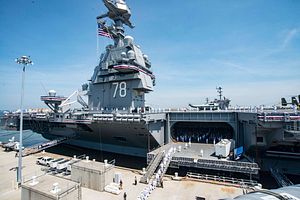On Saturday, July 22, U.S. President Donald J. Trump commissioned the USS Gerald R. Ford (CVN 78), the lead ship of the next-generation Ford-class U.S. nuclear-powered supercarriers.
An elaborate ceremony marked the commissioning of the first new class of U.S. aircraft carriers in 42 years. The Ford-class carrier will succeed the Nimitz-class carriers, which today form the entirety of the United States’ supercarrier force.
Gerald Ford, the 38th U.S. president for whom the new class of U.S. carriers is name, commissioned the USS Nimitz in 1975.
In his remarks on Saturday, Trump described the Ford as a symbol of American power on the seas. “American steel and American hands have constructed a 100,000-ton message to the world: American might is second to none,” Trump noted.
The Gerald R. Ford‘s commissioning comes just a little over one month after its delivery to the U.S. Navy at Newport News, Virginia. The carrier underwent builder’s sea trials earlier this year after taking to the sea for the first time in April.
Trump was accompanied by Secretary of Defense James Mattis, Acting Secretary of the Navy Sean Stackley, Chief of Naval Operations Adm. John Richardson, and USS Gerald R. Ford Commanding Officer Capt. Rick McCormack.
The most expensive single warship ever-built for the U.S. Navy at $13 billion, the Gerald R. Ford introduces several new and as-yet-unproven systems, including a new electromagnetic aircraft launch system (EMALS), two main turbine generators, new advanced arresting gears on the flight deck, a new radar system, and advanced weapons elevators.
The Ford-class is expected to be able to sustain much greater fighter sortie rates while applying less stress to its fighter airframes, reducing maintenance costs. The carrier’s new suite of digitized navigation software is also expected to reduce the overall size of her crew and lead to lower operating costs over the ship’s lifetime, according to the Navy.
The U.S. Government Accountability Office (GAO) expects a potential delay of up to four years between the USS Gerald R. Ford‘s commissioning and its eventual deployment pending ongoing testing of various systems.
The “incomplete work will be completed over the course of more than 4 years and is expected to cost nearly $780 million,” the GAO noted in a report released last week.
The next Ford-class supercarrier, the USS John F. Kennedy (CVN 79), is expected to be commissioned in 2020, continuing the phased replacement plan of the existing Nimitz-class carriers.

































